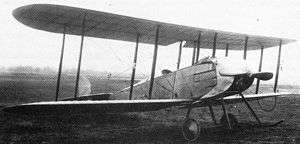Royal Aircraft Factory B.E.8
| Royal Aircraft Factory B.E.8 | |
|---|---|
 | |
| B.E.8 prototype | |
| Role | Two-seat general purpose biplane |
| Manufacturer | Various (designed at Royal Aircraft Factory) |
| Designer | John Kenworthy |
| First flight | 1913 |
| Introduction | 1914 |
| Retired | 1916 |
| Primary user | Royal Flying Corps |
| Number built | approx 70 |
|
| |
The Royal Aircraft Factory B.E.8 was a British two-seat single-engined general purpose biplane of the First World War, designed by John Kenworthy at the Royal Aircraft Factory in 1913.[1] Small numbers were used by the Royal Flying Corps over the Western Front in the first year of the war, with the type being used as a trainer until 1916.
Development and design
The B.E.8 was the definitive development of the earlier B.E 3 type, and the last of the B.E. series to be designed with a rotary engine. The main changes were that the fuselage now rested on the lower wing, in the normal way for a tractor biplane, and that the tail unit was changed to the B.E.2 pattern. Three prototypes were built at Farnborough with a single long cockpit for both crew members. The production aircraft had two separate cockpits and were built by sub-contractors. The improved B.E.8a of 1915 had new B.E.2c type wings, featuring ailerons instead of wing warping and a revised tail unit.
Operational history
Both models of the aircraft entered service with the Royal Flying Corps and a small number served in France in 1914 and early 1915 but most were used by training units.[2]
Variants
- BE.8
- Production aircraft with wing warping.
- BE.8a
- Production aircraft with ailerons.
Operators
Specifications (BE.8)
Data from British Aeroplanes 1914-18[3]
General characteristics
- Crew: 2 (pilot, observer)
- Length: 27 ft 3 in (8.31 m)
- Wingspan: 39 ft 6[4] in (12.04 m)
- Height: 9 ft 4 in (2.84[5] m)
- Powerplant: 1 × Gnome rotary engine, 80 hp (60 kW)
Performance
Armament
- Small arms operated by crew
- 1× 100 lb (45 kg) bomb
See also
- Related lists
References
Citations
| Wikimedia Commons has media related to Royal Aircraft Factory B.E.8. |
Bibliography
- Angelucci, Enzo. The Rand McNally Encyclopedia of Military Aircraft, 1914-1980. San Diego, California: The Military Press, 1983. ISBN 0-517-41021-4.
- Bruce, J.M. British Aeroplanes 1914-18. London: Putnam, 1957.
- Bruce, J.M. The Aircraft of the Royal Flying Corps (Military Wing) . London: Putnam, 1982. ISBN 0-370-30084-X.
- Hare, Paul R. The Royal Aircraft Factory. London:Putnam, 1990. ISBN 0-85177-843-7.
- The Illustrated Encyclopedia of Aircraft (Part Work 1982-1985). London: Orbis Publishing, 1985, p. 2819.